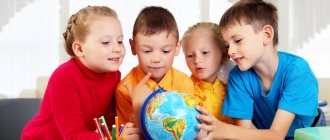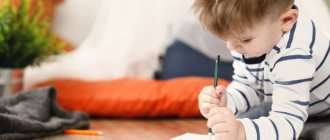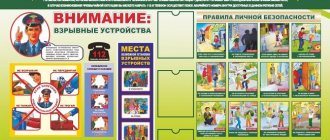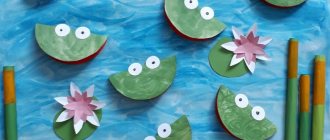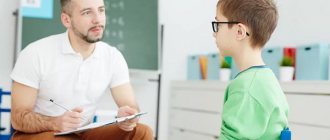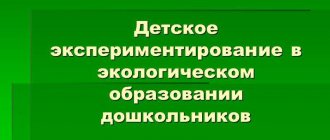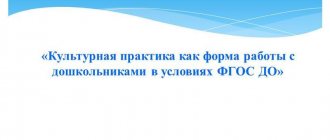What a child should know and be able to do before entering school
Preparing children for school takes a lot of time, so some parents prefer to send their children to private schools. Such institutions recruit groups of preschool children to learn everything they need under the guidance of professional teachers. At the same time, families should also regularly work with children, because in any case an individual approach is important. In order for a child to adapt to school subjects without great difficulty, he must:
- know letters;
- be able to read (possibly syllable by syllable) small simple texts;
- have writing skills;
- know the seasons, names of months, days;
- know your last name, first name, patronymic;
- have a good memory to remember 5-7 out of 10 clearly named simple words;
- find similarities and differences between objects;
- be able to subtract and add numbers within the first ten;
- know basic geometric shapes;
- know 10-12 primary colors, etc.
What do they do in these classes?
At this stage, the child should already have a certain level of thinking, memory, and attention.
Note! In addition, he needs to learn to interact with the teacher, classmates, be polite, be able to complete tasks, be independent according to his age, and learn to be organized. To learn all this, you don’t have to leave home and visit the school center.
What do they do in class?
Classes on teaching reading to future first-graders
Competent reading will allow you to solve several important problems:
- develop cognitive abilities;
- expand your vocabulary;
- develop grammatical structure of speech;
- form the basis of written speech, remember the correct spelling of words. That is, a child can independently write a letter to his grandmother or mother.
Drawing lesson on the theme “Spring” in preparatory groups
Preparatory classes for future first-graders in mathematics
The mathematician teaches:
- count (forward and backward counting, ordinal counting); write numbers, cursive;
- analyze, compare, summarize, classify;
- think figuratively, fantasize;
- be attentive, remember information;
- distinguish between the concepts “one”, “many”, “few”, “more”, “less”, “equal”;
- know and use signs of simple mathematical operations;
- navigate in time (know the parts of the day, the number and order of days in a week, weeks in a month, months in a year, seasons, have an understanding of hours and minutes);
- divide geometric shapes into parts, make shapes from parts;
- know the previous and subsequent numbers (for each number from the first ten);
- know simple units of measurement (kilogram, centimeter, liter);
- find similarities and differences between objects or their groups;
- compare the numbers of the first ten; compare objects by their size, area, color, shape;
- add and subtract.
Note! In order to interest the child, a certificate is issued at the end of the educational process.
Writing exercises
Teaching a child to sit correctly when writing, to hold a pen correctly and to navigate in space must begin already in pre-school. Note! When direct writing begins, a new and difficult activity for the child, it is much more difficult to do.
The recommendations include:
- exercises and tasks to practice differentiating the right and left parts of the body;
- exercises to develop orientation in the surrounding space and on the plane;
- exercises and task cards to prepare your hand for writing;
- exercises for the development of tactile sensitivity and complexly coordinated movements of the fingers and hands.
Methods for preparing children for school
Before giving any tasks to prepare your child for school, familiarize yourself with several popular methods. With their help, a child can acquire all the necessary skills during training. Teaching methods are usually aimed at developing fine motor skills, logical thinking, obtaining mathematical knowledge, etc. At the same time, taking into account the individual characteristics of the preschooler, it is necessary to engage in his physical training. Known methods of primary education:
- Zaitseva;
- Montessori;
- Nikitins.
Zaitsev's technique
To ensure that your child’s preschool preparation at home is successful, pay attention to Zaitsev’s methodology, which includes an approach to teaching reading, writing, English and Russian. It involves the use of visual perception of information. The main principle is to teach the child everything necessary without harm to health and taking into account individual characteristics. It is able to activate the channels of information perception, saving time and saving the child from cramming. Minus: with individual lessons, the methodology is implemented worse than with group lessons.
Montessori method
An individual school preparation program that helps prepare a future first-grader can be organized in accordance with the Montessori method. It pays great attention to the development of sensations and fine motor skills of the baby. It is not necessary to use any special aids during the learning process. Parents must create a complete developmental environment for their child. The disadvantage is the absence of role-playing and outdoor games in the methodology.
Nikitin's technique
To increase your level of knowledge with homework, check out the Nikitins’ method. Its main principles are development, which must be creative and free. Classes are held alternating: intellectual, creative, sports. The sports atmosphere plays a fundamental role in the formation of a child, so all conditions for this should be created in your home. The methodology is creative, with an emphasis on physical development and creativity, but there is a minus - not all children have a desire to learn.
What do you need for school?
Preparing for school is a very diverse process in which it is important to take into account the knowledge, skills and abilities of the future first-grader.
Psychological maturity
Assess how much the child understands that now his life will include not only games, but also educational activities.
First, pay attention to the emotional-volitional sphere: the future first-grader must control emotions. The inability to contain joy, anger, excitement, and resentment can affect relationships between classmates and affect the quality of studies.
Secondly, train your preschooler’s concentration and perseverance: teach your child to complete things he has started, without leaving them to the last minute. Organize home “lessons” - draw, sculpt, do shading, but always at the table and for 15-20 minutes, without interrupting for other tasks. Consistency and habit are important - to work strictly at the workplace, concentrating on a specific task. Household chores also help well in developing this skill: taking care of a pet, cleaning your room or watering flowers.
Preparatory classes for school
You need to start working with your baby from an early age. Particular attention must be paid to psychological preparation. At first, tasks are completed in a playful way, but then they become more complex but interesting. Children usually receive basic knowledge in kindergartens. You can achieve great results either at home by inviting a private tutor, or by sending your child to special development centers or preparatory courses at schools.
School preparation courses
When you decide to choose preparatory courses for school, be careful when choosing a suitable institution. Such courses are available both at the schools themselves and in educational centers, i.e. non-profit organizations. With the help of comprehensive classes and a team, children can adapt to the school system and lessons. Often, in such courses, preschoolers are taught so that they can easily complete the necessary exercises and answer certain questions correctly. It is much more important that the baby be able to think creatively, reason independently and draw conclusions.
Preschool tutor
A tutor for a preschooler is an excellent option to teach your child to read and write and prepare him for future interviews at school. Moreover, some teachers additionally teach children English. Do not forget that a tutor to prepare a child for school must have a pedagogical education and appropriate qualifications. The big advantage of tutoring is the individual approach, which will help develop attention, reasoning skills, etc. The child will gain deeper knowledge. Cons: difficult to find a decent teacher, high cost.
Preparation for school. Lesson No. 1: “Properties of objects. Sounds and words" (34 lessons in total).
Methodology for conducting classes to prepare for school in preschool educational institutions
To achieve the set goals and objectives, the teacher must not only wisely select the content of the lesson, but also logically build its structure.
Temporary GCD plan for school preparation
Like other classes with older preschoolers, the school preparation lesson lasts 25–30 minutes. This time frame includes 4 stages of work:
- Updating basic knowledge (introductory stage) - 2–3 minutes. The teacher motivates the children to work, the children repeat the material learned earlier, and check their homework if this type of work is expected.
- The main stage is up to 15 minutes. During this time, children become acquainted with new material, combining the information received with what they have already mastered. In addition, the main stage includes physical education (breathing exercises, finger games).
- Consolidation of what has been learned - up to 8 minutes. The studied material is systematized using practical techniques (making applications, drawings, etc.).
- The final stage is up to 4 minutes. The teacher comments on the work of the group as a whole and each child individually. Children evaluate themselves in class, that is, reflection is carried out.
An integrated lesson usually includes tasks in literacy, mathematics and environmental awareness.
Table: summary of the integrated educational activity “Back to school soon!” in the preparatory group (fragment)
| Author | Kharlanova I., teacher, kindergarten No. 10 "Bell", Kolomna, Moscow region. |
| Introductory stage | V.: Guys, let’s say hello to our guests and give them our smiles. Now everyone look at me and give me your smiles. Good morning, dear children and adults. This morning a package arrived to us, now we’ll see who it’s from (these children left our group for school a year ago). He opens the parcel and reads the letter: “Hello, dear friends! I'm doing well, I really like studying at school, I've made a lot of good friends. I try to study at “4” and “5”, and at school it is very important to be kind so that you have many friends. I know that you will also go to school soon, and therefore I have given you interesting tasks. When you complete them, a surprise awaits you. Good luck and success, see you soon." V.: I know that you want to go to school, but why? Children's answers...> |
| Main part | <… V.: Let’s see what the task is... You need to answer the questions with complete answers, are you ready?
Q: Let us remember what parts the task consists of? (From the condition and question).
V.: Well done! Let's create a problem based on the picture. Tell us your task. (Children's answers). <…> Do a graphic dictation:
V.: Let's see what's in the next envelope. You need to answer the questions:
|
| Consolidation of what has been learned | <… V.: Look: syllables are written on the envelopes. Let's try to make a word out of them. Children form the word “KINDNESS” and read it. Q: Guys, what do you think “kindness” is? <…> Children read poems about kindness and politeness. |
| The final stage | <… V.: Let us never forget kind, polite words. Let's say them to each other more often, speak kindly, gently, quietly, looking into the person's eyes. At the same time, smiling, because a smile makes a gloomy day brighter. A beautiful word that helps you live. All tasks have been completed. You handled everything well. What did you do today? (Children's answers). Look, we have another letter. “Well done! You did an excellent job with all the tasks and deserve a surprise. See you at school." The teacher gives the children medals - emoticons. V.: Thanks to our guests, teachers, thanks to our guys! |
| Quote from: https://www.maam.ru/detskijsad/konspekt-integrirovanoi-nod-na-temu-skoro-v-shkolu-v-podgotovitelnoi-grupe.html | |
Video: open integrated lesson in a preparatory school group
https://youtube.com/watch?v=YlOrFybQODI
Preparing for school is a long and systematic process that is carried out in kindergarten, starting from the first junior group. But if in primary and middle preschool age children master social and communication skills that are of key importance for the subsequent educational stage, then in older groups this work takes on the character of direct educational activity, that is, it is organized in special classes. As a rule, the teacher plans these lessons as integrated, that is, including work in all educational areas in accordance with the Federal State Educational Standard.
How much does it cost to prepare a child for school?
Preparatory courses will increase your child’s readiness for admission, especially if you plan to send him to a gymnasium. It is recommended to prepare in this way for those children who do not attend kindergarten. Classes in specialized institutions are aimed at mastering the basics of writing and literacy, learning to read, developing speech and musical skills, etc. Some centers teach chess, foreign languages, etc. Cost of training in Moscow:
| Center name | Cost in rubles |
| "A LITTLE PRINCE" | 600 for 1 lesson |
| "RAY" | from 7600/month 2 times/week |
| "CONSTELLATION" | From 28,000/month for children 4-6 years old, 5 times/week |
| "PRESIDENT'S SCHOOL" | Comprehensive training 11000 for 4 lessons of 90 minutes |
Free training
Kindergarten teachers must lay the foundations of counting, writing and reading. Parents are faced with a more important task - to teach their kids to finish what they start, let it be some examples from mathematics, a drawing lesson, or something else. To ensure that your child’s level of development corresponds to his age, try to communicate with him more, answering all questions. Pay attention to active games, physical development, teach independence and safety rules.
How to prepare your child for school yourself
To develop memory, the ability to think logically and other skills at home, read or watch cartoons together, discussing what the child has learned. Inquire about your child’s opinion more often by asking questions. Try to make home activities fun for your preschooler. The advantage of preparing a home is that it saves money, and the necessary materials can always be found on the Internet. The downside may be the quality, because not all parents have a pedagogical education. In addition, family activities do not always discipline the child.
- Kefir at night for weight loss - recipes. The benefits of kefir before bed for weight loss and cleansing the body
- Banana cake step by step
- Pain at waist level on right side
Where to start preparing
According to psychologists, the most suitable age for a future first-grader to begin education is considered to be 3-4 years. Start teaching your child to read and count in a playful manner, for example, while walking, count the number of houses, cars, etc. with him. Do crafts together, paying attention to the artistic development of the future first-grader: draw, create applications, sculpt, assemble puzzles. Set up a comfortable desk at home. Pay attention to your child's motivation, otherwise learning will progress slowly.
Program
You should not prepare your child for school in the abstract; try to find requirements, tests, assignments and specific examples of questions. To develop fine motor skills, a child must string pasta or beads, cut something out of paper, paint, create appliques, embroider, knit, etc. To teach your baby everything he needs, pay attention to the following lesson plan:
| Course name | Number of hours per week |
| Speech development, preparation for learning | 1 |
| Introduction to Mathematics | 1 |
| Development of motor skills and creative abilities | 1 |
| Getting to know the world around you | 1 |
| Introduction to Fiction | 1 |
| Preparing your hand for writing | 1 |
Materials
To teach your child everything he will need when entering school, use special visual materials. You can find them in large quantities on thematic web resources. To develop logical thinking, attention, memory and imagination, there are many educational games that require multi-colored cardboard. For example, to teach literacy you will need a picture book: choose any letter, say it several times and ask your child to trace it with a pencil all over the page. More details can be found in the manuals.
Games to prepare preschoolers for school
Educational games will help future preschoolers consolidate their knowledge of the alphabet, learn to form words, write and read. In addition, such activities help develop attention and concentration. Moreover, a preschool child is often distracted and cannot concentrate on one activity for a long time. Games that will help in the development of the baby:
- Title: "Book Detective".
- Goal: develop quick thinking, teach how to correlate letters with specific pictures.
- Material: book with illustrations.
- Description: give your child the task of finding a picture in a book that starts with a certain letter. If several children participate in the game, then introduce an element of competition, i.e. The winner will be the one who finds the most required pictures.
Here's another good option:
- Title: "Illustrator".
- Goal: to teach how to use a book, to develop logic and imagination.
- Material: several books.
- Description: read a short story or poem to your child, then invite him to select pictures from other books. Then ask them to retell a brief plot of what they read, based on the selected pictures.
Developmental activities
As developmental exercises, you can use any labyrinths where a character needs help getting to the exit or getting somewhere. There are many games that help improve concentration and increase its volume. Some exercises promote the development and voluntary attention. A good option for an educational game:
- Title: "Flowers in the Flowerbed"
- Goal: to develop logical thinking.
- Material: multi-colored cardboard.
- Description: cut out three flowers of blue, orange, red and three flower beds of rectangular, square, round shapes from cardboard. Let your child distribute the colors in the flower beds based on the story - red flowers did not grow in a square or round flower bed, orange flowers did not grow in a rectangular or round flower bed.
Another game that is great for developing a variety of skills in preschoolers:
- Title: “How are they similar and how are they different?”
- Goal: to develop logical thinking.
- Description: offer children two objects each, which they must compare and indicate their differences and similarities.
Course of lessons for future first-graders “Pathway to School”. Outline
Lesson 9.
Topic: Fire - friend or foe. (Fire safety at school.)
Goals:1. familiarize children with the benefits or harm that fire can bring to a person; 2. learn fire safety rules and rules of conduct in case of fire; 3. trace the connection between the topic of the lesson and literary works; 4. cultivate respect for the professions of firefighters, steelworkers, electric welders, etc.
Progress of the lesson.
1. Org. moment.
Warm up.
- “Lazy Eights” (the exercise activates brain structures that ensure memorization and increases stability of attention):
Draw figure eights in the air in a horizontal plane three times with each hand, and then with both hands.
- “Thinking Hat” (improves attention, clarity of perception and speech): “Put on your hat”, i.e. gently roll your ears from the top to the lobe three times.
2. Introduction to the topic. – Today we will talk about a very important topic for all of us. But which one, try to determine for yourself. I’ll tell you a riddle, and you tell me what we’ll talk about in class today.
Presentation “Fire - friend or foe?” slide 1
The red beast is sitting in the oven, the red beast is angry with everyone. He eats firewood out of anger for a whole hour, maybe two. Don’t touch it with your hand, It bites the whole palm. - The topic of our lesson is “Fire - friend or foe” or about fire safety rules at school. slide 2
- So what are we going to talk about? About safe handling of fire.
Slide 3
We say - fire is our friend! But suddenly he will become an enemy. If we forget about him, he will immediately take revenge on people. You will regret it in the battle with fire. Here he is scary and harsh - And from the house there is a lot of firewood!
— Fire has long been man's friend. Our ancient ancestors knew many secrets and tricks of making fire. They considered him a living creature, “tamed” him, settling him in their caves.
Slide 4 - He helped people fight for existence. He helped people prepare food. Fire saved us from the cold and helped in the fight against terrible predators, scaring them away from the caves and sites of ancient man.
Slide 5, 6 - Years passed. People got to know fire better and better. Fire in the eyes of people has lost the power of a deity. But he never stopped being a friend, an assistant. As in ancient times, it warms us and helps us prepare food.
Slide 7
— It is difficult to imagine such a branch of human activity where fire is not used. — Sometimes - at a campfire on a hiking trip or while fishing by the river. And most often on a comfortable and compact gas or electric stove.
Slide 8 - And there are also huge factory ovens. At the bakery, bread is baked in ovens. At a brick factory, bricks are fired from which houses are built. And in open-hearth furnaces, fire cooks steel. Pipes and machine tools, cars and airplanes are made from it.
Slide 9, 10- Fuel burns in the furnaces of power plants. This is where electric current is generated. It turns out that fire and electric current are closest relatives. The current illuminates our houses and streets; trams and trolleybuses move along its lines.
Slide 10.11
“Giant factories and the televisions, radios, vacuum cleaners, irons, refrigerators that work in our apartments are “powered” by electric current...
Slide 12
— A gentle ray of sun looks through your window in the morning. What is the sun? This is also fire.
Slide 13 - It faithfully serves people in everyday life and in production. - What professions do you know where a person uses fire?
Slide 14
“But it happens that fire turns from a faithful friend and helper into a merciless enemy, destroying in a matter of minutes what was created over many years of hard work.
Slide 15
— The strength of my friend – fire – is great – very great! But if this power is handled unwisely and carelessly, then fire can become a terrible, insidious enemy. The most terrible, most dangerous fire is the fire of war.
Slide 16
“It takes away human lives, wipes out big cities and small villages from the face of the earth. “But even in peacetime, fire, when out of control, can destroy a house, a village, and a forest.
Slide 17 - Every 5 seconds there is a new fire. Enterprises, hospitals, shops, ships, planes are burning. The fire does not spare museums and libraries, theaters and palaces, cultural monuments, schools, forests, and grain fields. — Every year there are 5 million fires in the world. Every hour one person dies in a fire, 2 are injured and burned. Every third person killed is a child.
- Why might a fire occur? — Give the reasons. (Children name the causes of the fire) - Fires often occur due to the fault of people, including schoolchildren. To prevent trouble from happening to you, remember these rules: slide 18, 19
CHILDREN NAME IN TURN ACCORDING TO ONE RULE. — Let’s repeat all the fire safety rules once again: 1. Don’t play around with matches and lighters. 2. When leaving home, do not forget to turn off electrical appliances. 3. Do not dry laundry over the stove. 4. Never light fireworks, candles or sparklers at home. 5. Do not approach the stove when it is burning and do not open the stove door. 6. Do not play with flammable or combustible liquids. 7. Don’t make a fire in the forest. 8. Do not set fire to poplar fluff or make a fire near buildings. 9. Don’t hang a paper lampshade on your lamp. 10. Be careful with gas.
— Guys, compliance with all fire safety rules will help the state save hundreds of thousands of rubles, and often the health and lives of people. - Remember, any prank with fire can lead to great misfortune! To the fire!
- But it happens that something bad happens and a fire starts, what should you do?
Let's get acquainted and learn the rules of behavior in case of fire: 1. If the fire is small, you can try to put it out immediately. How? (Blanket, water, sand, fire extinguisher).
Slide 20 2. If the fire does not go out immediately, immediately run away from the house to a safe place. (Is it possible to hide in secluded places during a fire? What needs to be saved first?)
Slide 21 3. If you cannot escape from a burning house, immediately call 01 and report the fire. After that, call neighbors and passers-by for help.
Slide 22 4. In a fire, smoke is much more dangerous than fire. If you feel like you are suffocating, kneel down and crawl towards the exit - there is less smoke below. Wet a cloth and apply it to your face. slide 23
5. If there is a fire in the entrance, never get into the elevator. He may shut down and you will suffocate. slide 24
6. While waiting for firefighters, don’t lose your head and don’t jump out of the window. You will definitely be saved. (But if the house is one-story, then on the contrary you need to break the glass and jump out).
Conversation about fire safety rules at school.
— How should we behave if a fire breaks out at a school? (Children's answers).
— If there is a fire in the school, the fire alarm goes off and in a stern voice asks you to leave the premises. Students must line up, count themselves and, together with the teacher, go up the stairs to the school stadium. Line up there. No one pushes or runs away from the class.
slide 25
7. When the firefighters arrive, obey them in everything and do not be afraid. They know better how to save you. (What can panic lead to?) slide 26
- Fire is not a toy. Every fire is a great misfortune, a great misfortune. Therefore, firefighters are always on guard day and night. slide 27, 28
Firefighters are people who risk their health and even their lives every day to save someone’s life and property. -Almost two centuries since firefighters appeared in our country. Look what life was like for the first firefighters. The tall tower is a tower. A fire can be seen from it: where there is fire, there is smoke. Firefighters and their families lived on the second floor. On the first - carts with water, hooks, ladders, horses. Horses are the best, the fastest!
Slide 29 - Firefighters were famous for their extraordinary daring and heroism. — Firefighters also have trains. In one car there is a pumping station, in the other there is a fire truck. This train has everything you need to fight fire. The duty locomotive will take him to the burning station or train. — There are also firefighting planes and helicopters. slide 30 -Firefighters train in speed, strength, agility.
Physical exercise: Game “This is me, these are all my friends” - I ask you questions, and you will answer in chorus: - “This is me, this is me, these are all my friends!” - Who, upon hearing the smell of burning, reports a fire? - “This is me, this is me, these are all my friends!!!” - Which of you, noticing the smoke, says: “Fire! We're on fire!" - “This is me, this is me, these are all my friends!!!” - Which of you plays pranks with fire in the morning, evening and afternoon? - Who, sensing gas in the apartment, will call “04”? - “This is me, this is me, these are all my friends!!!” - Who doesn’t light fires and doesn’t allow others? - “This is me, this is me, these are all my friends!!!” - Who, children, hides matches from their little sister at home? - “This is me, this is me, these are all my friends!!!”
Option 2 questions
If you can answer my question: “This is me, this is me, these are all my friends!” – then you remain standing, marching in place. If you mentally answer my question: “Not me!” - then, crouching, as if hiding.
Smoke suddenly rose in a column, Who didn’t turn off the iron?
Who, upon hearing the smell of burning, reports a fire?
A red glow ran, Who was playing with matches?
Who explains to the neighbor's kids in the yard that playing with fire doesn't end in fire for nothing?
A column of fire engulfed the attic, Who lit the matches there?
The fire ran into the yard, who was burning the fire there?
Whoever doesn’t set a branch on fire saves the forest from fire?
Who, children, hides matches from their little sister at home?
The flame jumped into the foliage, Who was burning the grass near the house?
Analysis of situations.1. - Now listen to the story that happened to Dunno.
Slide 31 - One day Dunno was invited to visit. He prepared very carefully: he took out a new suit and cleaned his shoes. The next morning, when Dunno woke up, he saw that he had overslept. What started here! Dunno ate a sandwich in a hurry and drank tea. I quickly pulled on my jacket, but it was wrinkled. Dunno turned on the iron and began ironing. He finished when the clock struck 11-00. Dunno quickly got dressed and ran out into the street. And the iron remained on the table... - What do you think happened next? slide 32
“It’s good that Znayka was at home and saw smoke coming out of the window of his neighbor’s house. He ran to the phone and dialed the number... The teacher attaches card 01 to the board. - What is this number? — Firefighters quickly arrived and put out the fire. Remember what can cause a fire? - That's right. Guys, Dunno has prepared a poem for you about the magic phone number 01.
This number is -01. Every citizen knows: If trouble comes to your house, call there as soon as possible. If you don't have a phone, call people from the balcony.
2. Situation: “Call the fireman.”
Children use a telephone to “call” firefighters. – What number should I call and how can I explain what happened? Call. (Children's answer options).
(Sample of the correct option: “Dial number 01. Is this the fire department? There is a fire in our house. Address: Yubileinaya street, building 1, apartment 17. Dima Ivanov speaking, phone 48251”)
- Why didn’t you say hello? (no time). What more could be said? (what exactly is burning)
GAME “Say the Word.”
One, two, three, four - Who has a fire in...? (Apartment). Smoke suddenly rose in a column. Who didn’t turn off....? (iron) A red glow ran. Who with the matches... (played) The table and the cabinet burned down at once. Who dried clothes over...? (with gas) A column of fire engulfed the attic. Who are the matches...? (lit) The flame jumped into the grass. Who was burning... near the house? (leaves.) Who threw Strangers into the fire...? (items). Every citizen remember this number... (zero one). I saw smoke - don’t yawn and the firefighters... (call). This should be clear to everyone. Why joke with fire...? (dangerous).
Work on sheets. (Color with colored pencils).
Summing up the lesson. Fire is a long-time friend of man. At all times, people have strived to use fire wisely. It warmed primitive people, with its help people learned to cook food and defend themselves from attacks by wild animals. Without fire, life on Earth is impossible. It is everywhere - in homes and schools, in factories and factories, in spaceship engines. But he can also be the worst enemy of people when he goes like a raging fire, destroying everything in his path. We must remember that a fire does not occur on its own. It always starts with a small tan. It is important to remember fire safety rules. And if you always follow them, then you will not need the rules for extinguishing fires, but you should not forget them either. And remember the words said by Vladimir Vysotsky: “We need to firmly remember that a fire does not occur on its own.”
How to psychologically prepare a child for school
The personal and social readiness of a preschooler lies in the fact that by the time of admission he must be fully prepared both for communication and interaction with peers and adults. For psychological preparation to be truly successful, provide the child with the opportunity to independently establish contacts with others on the playground.
So-called “children at home” are often afraid of large crowds of people, although not all adults feel comfortable in a crowd. At the same time, we should not forget that the future first-grader will have to be in a group, so try to get out to public events from time to time. Motivate your child - if he is used to constant praise at home, then evaluate not every step, but the finished result.
